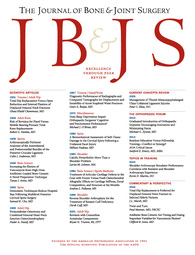
ARTHROPLASTY
Composite-beam and sliding-taper prostheses show no difference in femoral bone loss
This report has been verified
by one or more authors of the
original publication.
J Bone Joint Surg Am. 2013 Jan 2;95(1):19-27. doi: 10.2106/JBJS.K.00657
120 patients were randomized to evaluate whether the geometry of the cemented femoral prosthesis affected the pattern of strain-adaptive bone remodelling in the proximal aspect of the femur following total hip arthroplasty (THA). Patients received either composite-beam or sliding-taper (double and triple-tapered) prostheses and were assessed at 2 years. Results indicated that the magnitude and regional distribution of proximal femoral bone loss were similar between patients who received sliding-taper or composite-beam prostheses. Furthermore, similar bone remodeling pattern was observed between double and triple-tapered prostheses.
Unlock the full ACE Report
You have access to {0} free articles per month.Click below to unlock and view this {1}
Unlock NowCritical appraisals of the latest, high-impact randomized controlled trials and systematic reviews in orthopaedics
Access to OrthoEvidence podcast content, including collaborations with the Journal of Bone and Joint Surgery, interviews with internationally recognized surgeons, and roundtable discussions on orthopaedic news and topics
Subscription to The Pulse, a twice-weekly evidence-based newsletter designed to help you make better clinical decisions
Exclusive access to original content articles, including in-house systematic reviews, and articles on health research methods and hot orthopaedic topics
Or upgrade today and gain access to all OrthoEvidence content for just $1.99 per week.
Already have an account? Log in


Subscribe to "The Pulse"
Evidence-Based Orthopaedics direct to your inbox.
{0} of {1} free articles
Become an OrthoEvidence Premium Member. Expand your perspective with high-quality evidence.
Upgrade Now













































































